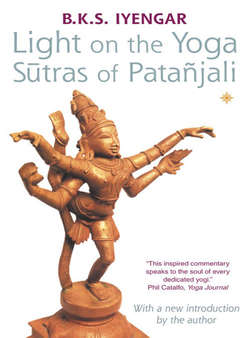Читать книгу Light on the Yoga Sutras of Patanjali - Литагент HarperCollins USD - Страница 9
The Yoga Sutras
ОглавлениеThe book is divided into four chapters or padas (parts or quarters), covering the art, science and philosophy of life. The 196 sutras are succinct, precise, profound, and devout in approach. Each contains a wealth of ideas and wisdom to guide the aspirant (sadhaka) towards full knowledge of his own real nature. This knowledge leads to the experience of perfect freedom, beyond common understanding. Through ardent study of the sutras, and through devotion, the sadhaka is finally illumined by the lamp of exalted knowledge. Through practice, he radiates goodwill, friendliness and compassion. This knowledge, gained through subjective experience gives him boundless joy, harmony and peace.
As with the Bhagavad Gita, different schools of thought have interpreted the sutras in various ways, placing the emphasis on their particular path towards Self-Realization, whether on karma (action), jñana (wisdom) or bhakti (devotion). Each commentator bases his interpretations on certain key or focal themes and weaves around them his thoughts, feelings and experiences. My own interpretations are derived from a lifelong study of yoga, and from experiences gained from the practice of Asana, pranayama and dhyana. These are the key aspects of yoga which I use to interpret the sutras in the simplest and most direct way, without departing from traditional meanings given by successive teachers.
The four chapters or padas of the book are:
1 Samadhi pada (on contemplation)
2 Sadhana pada (on practice)
3 Vibhuti pada (on properties and powers)
4 Kaivalya pada (on emancipation and freedom)
The four padas correspond to the four varñas or divisions of labour; the four asramas or stages of life; the three guñas or qualities of nature and the fourth state beyond them (sattva, rajas, tamas and guatita) and the four purusarthas or aims of life. In the concluding sutra of the fourth pada, Patañjali speaks of the culmination of purusarthas and gunas as the highest goal of yoga sadhana. These concepts must have been wholly understood in Patañjali’s time, and therefore implicit in the earlier chapters, for him to speak of them explicitly only at the very end of the book.
The ultimate effect of following the path laid out by Patañjali is to experience the effortless, indivisible state of the seer.
The first pada amounts to a treatise on dharmasastra, the science of religious duty. Dharma is that which upholds, sustains, and supports one who has fallen or is falling, or is about to fall in the sphere of ethics, physical or mental practices, or spiritual discipline. It appears to me that Patañjali’s whole concept of yoga is based on dharma, the law handed down in perpetuity through Vedic tradition. The goal of the law of dharma is emancipation.
If dharma is the seed of yoga, kaivalya (emancipation) is its fruit. This explains the concluding sutra, which describes kaivalya as the state which is motiveless and devoid of all worldly aims and qualities of nature. In kaivalya, the yogi shines in his own intelligence which sprouts from the seer, atman, independent of the organs of action, senses of perception, mind, intelligence and consciousness. Yoga is, in fact, the path to kaivalya.
Dharma, the orderly science of duty is part of the eightfold path of yoga (astanga yoga), which Patañjali describes in detail. When the eight disciplines are followed with dedication and devotion, they help the sadhaka to become physically, mentally and emotionally stable so that he can maintain equanimity in all circumstances. He learns to know the Supreme Soul, Brahman, and to live in speech, thought and action in accordance with the highest truth.
